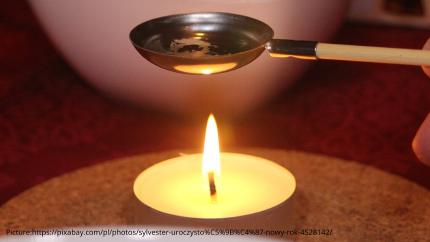New Year's Eve traditions.
Today it's New Year's Eve. Do you know any traditions related to this Day?
Let's start with Italian tradition.
One of the habits of New Year's Eve is to eat a specific meal. It consists of a lentil stew (small grains symbolize coins, so their consumption ensures prosperity in the coming year) and pork, usually served in a very spectacular way. Around midnight you should eat 12 grapes - each fruit is to ensure happiness for the coming year. Another traditional custom is to get rid of old things at the end of the year to get ready for new ones.

What about Germany?
Let me present you the German tradition, called Bleigießen. In order to anticipate the future, lead is poured in Germany on New Year's Eve (der Silvesterabend). This custom dates back to Roman times. A small piece of metal is heated (erhitzen) (most often in a spoon above the candle), and after it melts, it is poured into water. After cooling, the shape is fished out and the participant tries to guess whether it means something good or bad. In the Middle Ages, lead was very popular, bullets were made of it (das Geschoss). Today, this habit is increasingly being abandoned, because lead vapors are very poisonous (giftig).

In Austria?
The inhabitants of Austria believed and believe in the magical power of talismans, the so-called Glücksbringer. The most popular example of such an amulet is a pig. On New Year's Eve, this can be seen at every turn - on hats, T-shirts, key rings and plates. Mumps symbolizes happiness, prosperity, fertility and wealth, so on the last day of the year everyone gives their loved ones a pig made of marzipan or yeast dough.
And what about Chech Republic?
It is believed that then it is worth taking out all the rubbish, changing the bedding and doing the laundry so that no unpleasant things from the previous year remain at home. On the occasion of the New Year, the Czechs send themselves so-called novoročenkas, i.e. greeting cards. It is interesting that this custom is older than Christmas cards and was invented by the Czech nobleman Count Karel Chotek, who in 1827 came up with an idea how to deal with the procession of guests who used to visit him on the occasion of the New Year, so he began to send them wishes written on decorated paper.
Do Slovakian have some tradition?
Sure. The last day of the year, December 31, in Slovakia, is celebrated in memory of Pope Sylvester I, of which little is known. It was believed that the night of December 31 to January 1 has magical power. It was believed that evil powers could be released that night. People chased them off with a whip, trumpet, etc. Today at midnight fireworks are lit and toasts are raised to welcome the New Year.
How the New Year's Eve looks in Hungary?
Hungarians welcome the New Year with family and friends by playing together at home, restaurants or on New Year's Eve outdoor events organized in many major Hungarian cities. January 1 is also an exceptional day. Pork meat and lentils (usually in the form of soup) are brought to the tables so that the coming months will be filled with prosperity. The cooking of chickens is avoided, because it heralds the insufficient coming year. On the New Year, the Hungarians shun their efforts and, in particular, try not to spend money. All this because they believe that the activities performed on January 1 will be repeated during the whole year.
Welcoming the New Year is an important event for Slovenes, that's why in every major city, especially in Ljubljana, concerts are held on New Year's Eve, and then also on the New Year itself. Because in this small country there is a belief that what a New Year, such a whole year - many Slovenians try to spend this day in the most pleasant way for themselves. Skiing, cross-country skiing, sledding, family outings and fun are then on the agenda. This day looks very special in Portorož, where a traditional jumping competition takes place to the Adriatic. Sometimes even several hundred people take part in it.
And now it's Poland's turn...
To this day, it is believed that if we want to get rid of unpleasant memories, it is best to write them down on the paper and then burn it. Fire lit on New Year's Eve means symbolic purification and forgetfulness. However, we should remember that on New Year's Eve we should not clean up the house, because in this way we can "sweep" happiness from our lives. It was only in the nineteenth century that the New Year's custom appeared, which consisted in organizing sumptuous New Year's Eve parties and balls, which became widespread throughout the country during the inter-war period.
As tomorrow is the New Year Day, we'd like to wish you all the best in New Year 2020:
May 31st December be the end of your sorrows and 1st January 2020 be the beginning of your joys.

